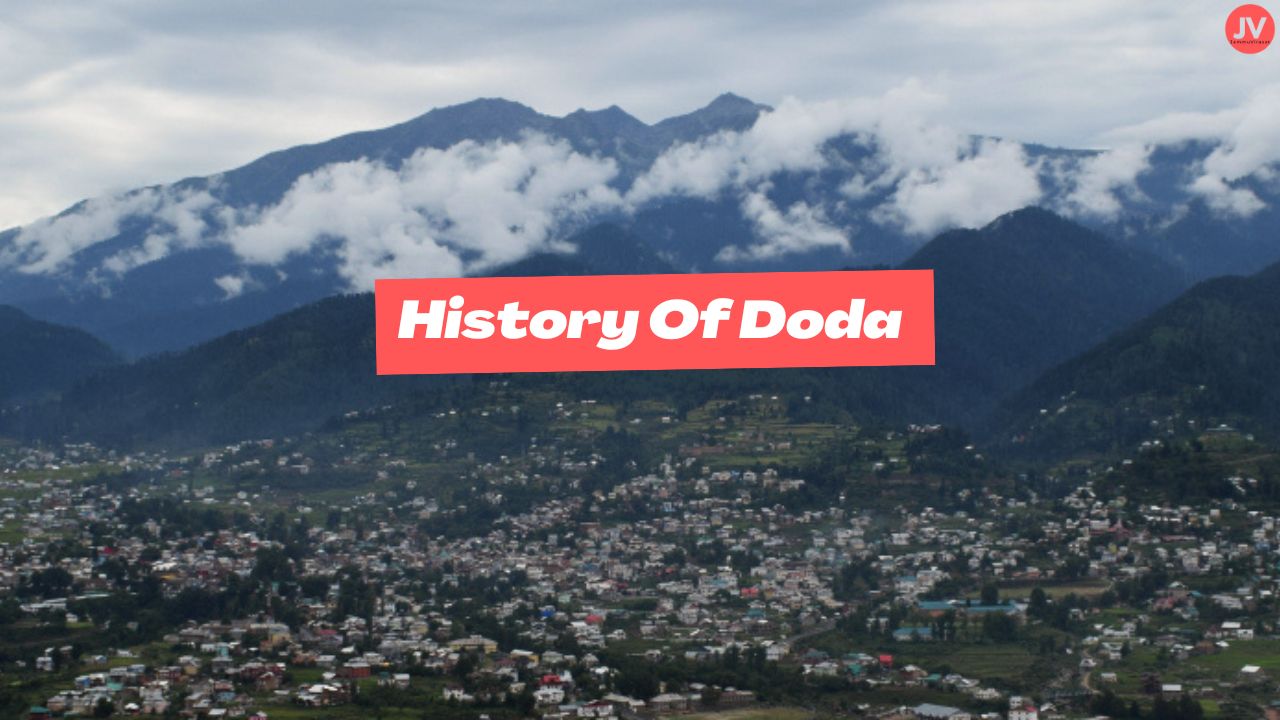Doda, a district nestled in the Chenab Valley region of Jammu and Kashmir, is a place of historical and cultural significance. The name “Doda” has a fascinating origin story tied to its ancient past and its headquarters. The history of Doda is intertwined with the legacies of rulers, battles, and unique cultural practices that have shaped its identity over centuries.
Origin of the Name “Doda”
The district of Doda derived its name from its main town, also known as Doda. Historical records, particularly (Misli Haqaqit) maintained by the State Revenue Department, the district Doda, like other districts has derived its name from its district headquarters situated at Doda. The records reveal that one of the ancient Rajas of Kishtwar whose dominion extended beyond Doda persuaded one utensil maker namely Deeda a migrant from Multan (Pakistan) to settle permanently in his territory and set up a utensil factory there. Deeda is then said to have settled in a village which later on came to be known after him. With the advent of time, the name Deeda seems to have got distorted into Doda, by which name it continues to be known today.
History of Doda : Early Rulers and Dynasties of Doda
The ancient history of Doda, much like other regions of Jammu and Kashmir, is sparsely documented. The available records primarily focus on the regimes of Kishtwar’s rulers. The chronicles mention that the region was governed by a series of local chieftains and ruling families, including the Ranas, Rajas, and other independent chiefs. Notable ruling clans included the Jaral Ramas, Katoch Rajas, Bhaus, Manhases, Chibs, Thakkars, Wanis, and Gakkars. These dynasties played crucial roles in shaping the socio-political landscape of the region.
Doda: The Winter Capital of Kishtwar
Doda held strategic importance as the winter capital of the erstwhile Kishtwar state. The historical significance of this region can be traced back to 1822 AD when Maharaja Gulab Singh, a prominent figure in Jammu and Kashmir’s history, conquered Doda. Instead of using force, he won the hearts of the local population, ensuring their loyalty and support. This peaceful conquest marked a turning point in Doda’s history, leading to its development and integration into the larger princely state.
The English Traveller G.T. Vigne, who visited Doda in 1829, has written in his travelogue:-
“I travelled from Bhaderwah towards Doda along the nullah there is a deep and rocky nullah, where the Chenab joins it, which I crossed over one of the dangerous bridges I had seen in Himalayan range. The distance of perpendicular rocks is about sixty yards and the bridge is about fifty feet height over the nullah. These pillar less bridges are usually of two types. One like that of Doda. Its structure is like this: A strong rope is spread up to the banks of the river without a swing and tied strongly with the rocks. Like the seat of the cradle a wooden structure slips over the rope. Other ropes are tied to this structure by means of which the structure comes and goes backwards and forwards. The other type of bridges is crossed on foot. Small ropes are bound with small pieces of bark of the boughs and then a thick rope is made of these small ones. This is tied on both the banks of the river, which provides the traveller to place his foot on it. This rope is not thicker than six, seven or eight inches but it is intertwined in such a manner that the tips of the boughs stay outwards and prevent feet from slipping. On both the sides of this rope about four feet high there are hanging ropes, made of the same stuff, which a person crossing the river catches hold of. These ropes are tied with the big rope at a distance of one yard each. The local people do not need any guidance that they should catch hold of the rope strongly and that they must ensure their back foot is firmly fixed before taking the second step.’’
The Remarkable Bridges of Doda
Vigne noted the presence of two types of traditional bridges:
- Rope Bridges: These bridges featured a strong rope stretched across the river’s banks, creating a pathway suspended high above the water. A wooden cradle-like structure slid over the rope, allowing travelers to cross the river. The locals skillfully maneuvered these bridges, displaying remarkable agility and balance.
- Foot Bridges: The second type involved thick ropes made from intertwined bark fibers, providing a narrow but sturdy footing. Travelers held onto side ropes for support while crossing, showcasing the ingenuity and resourcefulness of the local people in constructing safe passageways across the perilous Chenab River.
The Historical Significance of Doda Fort
One of the most notable historical landmarks in Doda was the Doda Fort. According to historian Thakur Kahan Singh Balowria, the region once boasted around seventy forts, including smaller ones in the Poonch area. These forts served multiple purposes, such as storing armaments, housing defense equipment, and serving as administrative offices for local authorities.
The Doda Fort held particular significance due to its strategic location. Constructed on the left bank of the Chenab River, it provided a vantage point to monitor potential threats from the Rajas of Bhaderwah. Maharaja Gulab Singh, during his reign, renovated and strengthened the fort’s defenses, ensuring its readiness against invasions.
Read also: Gumat Gate, The Walled City of Jammu: A Look into Its History
Architectural Features of Doda Fort
The architecture of the Doda Fort was impressive, reflecting the defensive strategies of the era. The fort’s walls, made from large unbaked bricks measuring 3×2 feet, were around four feet thick and soared to heights of 40 to 50 feet. Dome-like towers adorned the corners, featuring holes for surveillance, allowing guards to keep a close watch on enemy movements. The fort’s walls also had strategically placed windows for ventilation and observation.
One of the most intriguing features of the fort was the Chah Bacha, a deep pit in the courtyard. It was reportedly used to imprison notorious criminals during the winter months. This aspect of the fort’s history hints at the turbulent times it witnessed, filled with tales of rebellion, loyalty, and political intrigue.
Demolition of the Historic Fort
The once-majestic Doda Fort met an unfortunate end in 1952 when the government ordered its demolition. The fort, which had witnessed centuries of historical events and held countless stories within its walls, was reduced to rubble. Today, the site is home to the Government Boys Higher Secondary School Doda, a modern educational institution that stands as a reminder of the region’s evolving landscape.
Read also: Naama Set: The Iconic Jewellery of Dogra Heritage
Preserving the Legacy of Doda
The history of Doda is a captivating blend of cultural exchanges, strategic conquests, and architectural marvels. While much of its early history remains shrouded in mystery, the available records paint a picture of a region that has seen the rise and fall of various rulers, each leaving an indelible mark on its landscape. The story of Doda, from its humble beginnings as a settlement named after an artisan to its role as a strategic winter capital, is a testament to the resilience and adaptability of its people.
Today, as the district embraces modernization, efforts to preserve its historical legacy and cultural heritage continue. The remnants of its past, including the stories of the ancient fort and the traditional bridges, offer a glimpse into the vibrant history that shaped this unique part of Jammu and Kashmir.
















